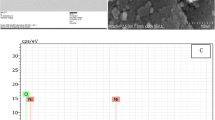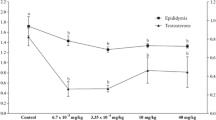Abstract
Nickel sulphate was administered orally to adult male mice at dose level of 5 and 10 mg/kg body weight (5 days per week) for 35 days. There was no change in body weight. However a significant decrease in absolute and organ-to-body weight ratios of testes, epididymides, seminal vesicles and prostate gland was observed. The sperm abnormality, associated with decrease in sperm motility and sperm count was also observed. Significant alterations in the activities of marker testicular enzymes, viz. sorbitol dehydrogenase (decreases), lactate dehydrogenase (increases) and γ-glutamyl transpeptidase (increases) associated with histopathological changes in testes, epididymides and seminal vesicles, were also observed. Accumulation of nickel in testes, epididymides and seminal vesicles was also observed. The study reveals that the oral exposure to nickel may affect the histology of testes, epididymides, seminal vesicles and sperms morphology. These testicular and spermatotoxic changes may be responsible for observed male mediated developmental toxic effects.
Similar content being viewed by others
References
Adelman MM, Cahill EM. 1936 Atlas of Sperm Morphology USA: ASCP Press.
Benson JN, Burt DG, Carpenter RL. 1988 Comparative inhalation toxicity ofnickel sulphate to F344/N rats & B6C3F1 mice exposed for twelve days. Fund Appl Toxicol 10(1): 164-178.
Blackshaw AW. 1970 Histochemical localization of testicular enzymes. In: Gomes WR, Johnson AD, eds. The Testis. New York, Academic Press, 73-231.
Deknudt G, Leonard A. 1982 Mutagenicity tests with nickel salts in the male mouse. Toxicology 25: 289-292.
Dixon Robert L. 1986 Toxic responses of the reproductive system. Casarett and Doull's Toxicology, Klaassen CD, 3rd edn. New York, Macmillan Publishing Company, 433-477.
Dunnick JK, Gupta BN, Harris MW, Lamb JC. 1984 Reproductive toxicity of dimethyl methyl phosphate (DMMP) in the male fisher 344 rat. Toxicology Appl Pharmacol 72: 379-387.
Environmental Health Criteria 108: 1991. Nickel, Geneva, World Health Organisation.
Fischer RA. 1950 In: Statistical Methods for Research Workers. 11th edn, London, Oliver & Boyd.
Freund M, Carol B. 1964 Factors affecting haemocytometer counts of sperm concentration in human semen. J Reprod Fertil 8: 149-152.
Gerlach U. 1983 Sorbitol dehydrogenase. In: HU Bergmeyer J, Bergmeyer, M GraBL, eds. Methods of Enzymatic Analysis. Vol. III, 3rd edn. Weinheim, Verlag Chemie, 118-126.
Hemavathi E, Rahiman MA. 1993 Toxicological effcts of Ziram, Thiram, and Dithane M-45 assessed by sperm shape abnormalities in mice. J Toxicol Environ Health 38: 393-398.
Hodgen GD and Sherins RJ. 1973 Enzymes as marker of testicular growth and development in the rat. Endocrinology 93: 985-989.
Hoey MJ. 1966 The effects of metallic salts on the histology and functioning of the rat testes. J Reprod Fert 12: 461-471.
Jacquet P, Mayence A. 1982 Application of the in vitro embryo culture to the study of the mutagenic effects of nickel in male germ cells. Toxicol Letters 11: 193-197.
Kamboj VP, Kar AB. 1964 Antitesticular effect of metallic and rare earth salts. J Reprod Fert 7: 21-28.
Leblond CP, Clermont Y. 1952 Definition of the stages of the cycle of the seminiferous epithelium in the rat. Ann NY Acad Sci 55: 548-573.
Lowry OH, Rosebrough NJ, Farr AL, Randall RJ. 1951 Protein measurement with the Folin phenol reagent. J Bio Chem 193: 265-275.
Mathur AK, Dikshith TSS, Lal MM, Tandon SK. 1978 Distribution of nickel and cytogenetic changes in poisoned rats. Toxicology 10: 105-113.
Meistrich ML. 1989 Evaluation of reproductive toxicity by testcular sperm head counts J Amer Coll Toxicol 8: 551-567.
Morales P, Katz DF, Overstreet JW, Samules SJ, Chang RJ. 1988 The relationship between the motility and morphology of spermatozoa in human semen J Androl 9: 241-247.
Nebbia C et al. 1987 Effect of the chronic administration of sodium selenite on rat testis. Res Commun Pathol Pharmacol 58: 183-197.
Ng TB, Liu WK. 1990 Toxic effect of heavy metals on cells isolated from the rat adrenal and testis. In Vitro Cell Dev Biol 26: 24-28.
Nordberg FG. 1975 Effects of long-term cadmium exposure on the seminal vesicles of mice. J Reprod Fert 45: 165-167.
Oehninger SA, Costa AA, Morshedi M, Veek L, Swansor RJ, Simmons K. 1989 Charactive measures and pregnancy outcome in invitro fertilization in patients with severe sperm morphology abnormalities. Fertil Steril 50: 283-287.
Pant N, Prasad AK, Srivastava SC, Shanker R, Srivastava SP. 1995 Effect of oral administration of carbofuran on male reproductive system of rat. Hum Exp Toxicol 14: 889-894.
Prasad AK, Pant N, Srivastava SC, Kumar R and Srivastava SP 1995 Effect of dermal application of hexachlorohexane on male reproductive system of rat. Hum Exp Toxicol 14: 484-488.
Prasad AS. 1976 Trace elements in human health and disease, Vol I. Essential and Toxic Elements. New York, Academic Press, 379-387.
Putt FA. 1972 Manual of Histopathological Staining Methods. A Wiley Interscience publication. New York, John Wiley and Sons.
Ronis MJJ, Badger TM. 1996 Reproductive toxicity and growth effects in rats exposed to lead at different period during development. Toxicol Appl Pharmacol 136: 361-371.
Roomi MW, Goldberg M. 1981 Comparison of t-glutamyl transferase induction by phenobarbitol in the rat, guinea pig and rabbit. Biochem Pharmacol 30: 1563-1571.
Sharma et al. 1996 Reversible effects of mercuric chloride on reproductive organs of the male mouse. Reproductive Toxicology 10(2): 153-159.
Sherins RJ, Hodgen GD. 1976 Testicular gamma glutamyl transpeptidase an index of Sertoli cell function in man. J Reprod Fertil 48: 191-193.
Sobti RC, Gill RK. 1989 Indices of micronuclei and abnormalities in the head of spermatozoa caused by the salts of heavy metals, Nickel. Cytologia 54: 249-253.
Srivastava S, Seth PK, Srivastava SP. 1992 Effect of styrene on testicular enzymes of growing rat. Ind J Exp Biol 301: 399-401.
Sunderman FW Jr, Aitio A, Morgan LG. 1986 Biological monitoring of nickel. Toxicol Ind Health 2: 17-78.
Vassault A. 1983 Lactate dehydrogenase. In: HU Bergmeyer, J Bergmeyer, M Grabl (eds.). Methods of enzymatic analysis. Vol III 3rd edn, Weinheim, Verlag Chemie, 118-126.
Toxiocology Profile Nickel. 1997 U.S. Department of Health and Human Services, Public Health Services. Agency of Toxico Substances and Disease Registry.
Waltschewa W, Slatewa M, Michailow IW. 1972 Testicular changes due to long term administration of nickel sulphate in rats. Exp Pathol 6: 116-120.
Author information
Authors and Affiliations
Rights and permissions
About this article
Cite this article
Pandey, R., Kumar, R., Singh, S. et al. Male reproductive effect of nickel sulphate in mice. Biometals 12, 339–346 (1999). https://doi.org/10.1023/A:1009291816033
Issue Date:
DOI: https://doi.org/10.1023/A:1009291816033




